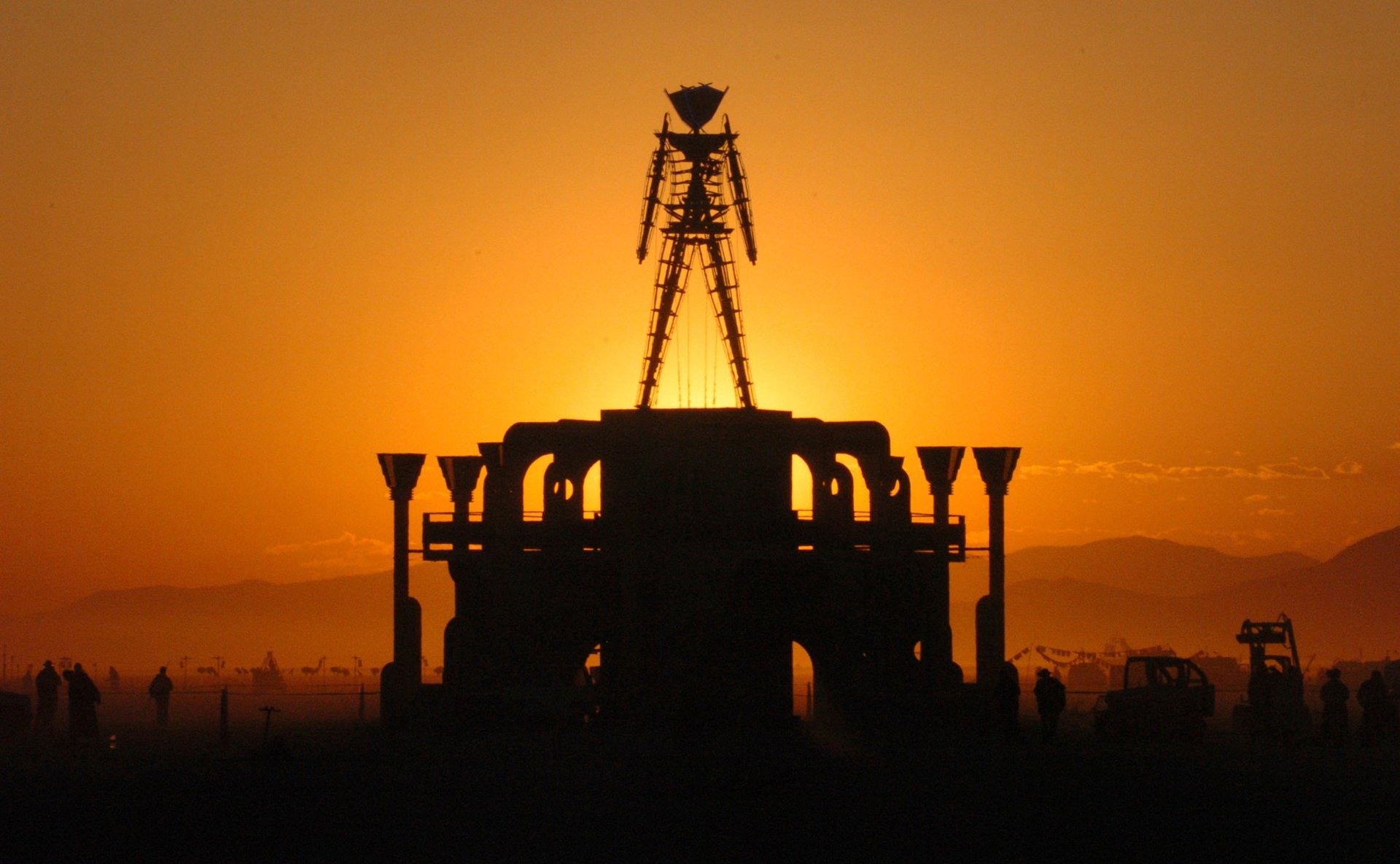Technology-oriented religions are coming
In the beginning, technologists created the science fiction. Now the fiction was formless and empty, and darkness lay over the surface of the science, and the spirit of mathematics hovered over their creation. And the technologists said, “Let there be Internet” and there was connection. Technologists called the Internet “community” and the science they called progress. And there was community and there was progress


In the beginning, technologists created the science fiction. Now the fiction was formless and empty, and darkness lay over the surface of the science, and the spirit of mathematics hovered over their creation. And the technologists said, “Let there be Internet” and there was connection. Technologists called the Internet “community” and the science they called progress. And there was community and there was progress
The first day, from The Neosecularia, 1.1-1.3
Religious ideas and powerful radical theologies pepper our science fiction. From Klingon religions in Star Trek to the Bene Gesserit in the Dune series, Cylon in Battlestar Galactica to the pervasive Cavism in Kurt Vonnegut’s works, our society has little trouble imagining the concept of new religions. We just don’t implement them.
Modern society has been unsuccessful in scaling new religions beyond the cults of personality or the niches of Scientology. But as the digital and virtual worlds evolve, this is set to change. The 21st century is setting the stage for a new type of widespread faith: technology-based religions.
Technology today is pervasive and granulated. It encompasses our world view, and people are translating it into their spiritual views. The internet acts as an accelerant on these forces, enabling cross pollination and mutation at rapid rates. This slippery-slope of transmutation provides new guardrails for how technology itself can become a new cult or religion, or at least a component of them.
Techno-oriented religious movements represent a big departure from the strategies of 20th-century-style cults, which could make them even more dangerous. The foundations for this growth are governed by three factors: the internet, which allows for rapid scale; quantified-self technologies, which promise self-betterment; and new surveillance methods, which ensure a whole new type of peer-pressured submission.
Rapid ability to s
cale
Today’s major religions, including Christianity, Judaism, Islam, Buddhism, and Hinduism, took hundreds of years to propagate. Their turning points from small factions to true movements happened when they addressed social injustices. The paganism of the Romans was one thing, but it was their injustices to the people of Judea that gave ground for the rise of Judaism, and later Christianity. In 1517, the sale of Roman Catholic indulgences sparked Luther’s Ninety-Five Theses on Power and Efficacy of Indulgences, kicking off the Protestant movement, and revolting against perceived corruption by the Church.

Tech-backed movements like the Arab Spring, Black Lives Matter, and #ClimateStrike scaled by tapping into a growing sense of social injustice. Right or left, economic inequality is becoming visible on a global scale, and technology is connecting all of those audiences into one digital network tasked to affect change. Instead of legal or economic changes, these movements rely on social agreement as their first outcome. Social agreement is powerful, and represents a type of group-think that can evolve quickly into action when it reaches a tipping point.
Today we have the ability to scale audiences to extremes and have instant access to whatever Reddit or Facebook group will best serve a message. No more wandering the plains of medieval Europe seeking people to convert—social media has brought billions of people right to you from the safety of your couch.
There is a huge audience of lonely people looking for spiritual answers to social injustice. A 2018 Cigna report indicated 47% of Americans feel lonely “sometimes or always,” while a PRRI 2017 study further showed that 18% of Americans are spiritual but not religious, and 69% are some combination of the two. And it’s not just in America: 84% of the global population identifies as religious, according to Pew Research Center, which makes it relevant globally, from Beijing to Lagos to Ohio.
The internet has made social injustice more visible, movements easier to start, and causes easier to join. While tech-led social movements are not yet religious movements, they lay the groundwork for mutated spiritual movements to copy similar values and conditions to gain scale.
Augmented mindfulness
Over the last several years, mindfulness—defined as paying attention to our thoughts and feelings without judging them—has exploded into popular consciousness. It is a part of a wellness movement focused on inward explanation, breath work, yoga, and meditation that has brought people tools of personal growth and empowerment.
The next phase of this obsession with self-betterment is augmented mindfulness. Quantified-self devices track all manner of biological and mental functions in the form of everything from electrocardiograms on the latest smartwatches or brainwave scanners like Emotiv promising to one day map emotions. To take it one step further again, neural interfaces such as Neuralink, Elon Musk’s project, promise mind-reading threads embedded in your brain that connect your emotions to the computer. Likewise, Facebook is building algorithms to decode brain activity into words that can be processed in real time. We’re only one big jump from a computer being able to outright read your thoughts.
Traditional religions have connected humanity to feelings of unity and higher purpose. Augmented mindfulness is set to upend our perceptions of the boundaries between ourselves and our purpose, virtual or real.

But can technology process God into something we can finally understand? The results are most evident in the upper echelons of technology’s inner circles, where blockchain builders, yogic shape shifters, and Burning Man believers turn into transhumanist experimenters actively discussing this question. If only enough computing power is thrown at the equation, the thinking goes, we will ultimately connect the dots. (Some people theorize that reality looks like a post-chaotic 248 vertice lattice structure called an E8. That’s a rabbit hole you’ll have to Google.)
Peer
surveillance
The third component is related to AI and its insatiable need for large amounts of data, which coincides nicely with the work of governments around the world installing pervasive surveillance systems in the fight against terror, speeding, or human freedom, depending on your domicile. Whether it is the growing pressure of the Chinese social credit system, the parsing of billions of consumer mobile conversations by the NSA, or the elimination of cash in favor of digital wallets and identities across India, the data explosion has morphed into a shared Permanent Record (as so well articulated in Edward Snowden’s book of the same name).
Peer surveillance and group think is a hallmark of religious pressure, especially in cults, where the enforcement of principles handed down by the leadership is performed by the crowd. Setting these norms and enforcing them in this emerging world becomes the responsibility not of individual peers, but by the algorithmic decisions of vast data inputs from the crowd.
The outline of this alpha network is taking shape, with monolithic corporate tech control in the West, a party-controlled AI network in China, and even plans for a pan-Islamic AI system, announced by Saudi crown prince Mohammed bin Salman at his annual investment conference in 2018. All of these systems seek to process the large data sets of aggregated surveillance (benign or otherwise) in order to provide shared intelligence about their respective societies, and will eventually be applied in wider circles among differing actors, until it’s inescapable.
* * *
Together, these trends point the way to fertile ground for digital cults and religions in methods and ways foreign to our past. Is Greta Thunberg’s climate revolution the beginning of a movement, and a new ecological mandate? Are the Neo-Nazi far right seeking a spiritual home for deep rhetoric? And most importantly, how will any of us resist the temptation to just follow along when everyone else in your social network has joined whatever the Fortnite-WhatsApp-TikTok-mashup of all of that becomes?
We feel pressured into joining whatever new social media platform is de jour or downloading whatever buzzy app everyone else is using—what happens when these forces coalesce into social movements that demand more from us? The technological tools are there, and so is the social pressure to enlist—as well as our lack of individual ability to resist.
At some level, everything is about control. It is worth being wary of how these technologies are being used, who is advocating for them, and who owns them, to make sure their evolution is in our best interest. Religions can be a wonderful and inclusive tool pushing society forward—but the line between the freedom to pursue religion and the pressure to conform to new one should be carefully guarded.
Beware of false technologists, which come to you in sheep’s clothing, but inwardly they are ravening wolves.
From the Neosecularia, Machinas 7:15